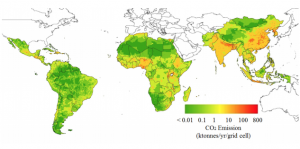Scale, Integration & Mechanism for Building Alternative Scenarios
Ongoing Projects
Physically-based understanding of residential energy choices

Spatial distribution of particulate matter (PM) emissions by Winijkul, Fierce, and Bond. Emissions are plotted on a log scale. Grid cells are 0.04×0.04 degrees. Click to view in original publication.
Cooking, heating, and other activities in homes are major sources of indoor and outdoor air pollution, especially when solid fuels like wood or animal dung are used to provide energy. Estimates of residential emissions and the potential for mitigating them are often made using nationally-averaged data, painting the problem and its possible solutions with the single stroke of a broad brush.
Mitigation strategies instead need to be user- and situation-focused. This project develops that focus by estimating regional differences in user energy choices based on type of household task and the fuel resources available to users.
Researchers developed a method to disaggregate known data on total energy used in residences by end-use (task), probable fuel source (based on land type), and efficiency of combustion technologies. The resulting spatially-distributed emissions and use requirements can inform scientists and organizations in identifying solutions to air pollution for distinct situations.
Funded by the U.S. Environmental Protection Agency.
Completed Projects
Emissions forecasting for U.S. interregional land-based freight system through 2050
 Freight shipments in the U.S. are burgeoning in the face of a growing domestic economy and greater globalization of many industries. Freight transportation relies heavily on trucking and rail shipments, which consume a combined total of 70% of the energy used in moving goods.
Freight shipments in the U.S. are burgeoning in the face of a growing domestic economy and greater globalization of many industries. Freight transportation relies heavily on trucking and rail shipments, which consume a combined total of 70% of the energy used in moving goods.
Previous studies of freight transportation have looked as various aspects of impact: infrastructural needs, greenhouse gas emissions, regional loads, but never before has a project evaluated all of these areas simultaneously. Our researchers combined models of economic scenarios, freight demand and transportation method, fuel consumption, and emissions by known technologies to envision possible scenarios for America’s emissions future. By considering and integrating all the factors at play, we identify the limiting factors in decreasing emissions from freight transportation.
Funded by the U.S. Environmental Protection Agency.
Vision
SIMBAS (Scale, Integration & Mechanism for Building Alternative Scenarios) seeks to improve fidelity in storylines of the environmental future.
Scenarios are not predictions, but visions of what the future might be. Scenario modeling allows exploration of possible alternative worlds. This modeling is a means to investigate sensitivities, important turning points, and binding constraints that may lock in or prevent certain future paths. Our belief is that scenario modeling, with just enough detail, can encourage a more informed public discussion of near-future decisions, far-future consequences, and the paths we travel on the way to those futures.
Principles
What is meant by “just enough” detail? Scenario development has three core principles: Mechanism, Scale, and Integration, applied in that order.
Mechanism: If one doesn’t know how it happens, then one doesn’t know how to make it happen. SIMBAS favors the representation of physical, technological and social principles and dynamic modeling rather than inference from empirical trends.
Scale: Both small and large scales are needed to understand action, changes, processes, and impact. We imagine the future as a mosaic in which one may both understand the tiles and visualize the picture. One can’t model every reaction or transaction on Earth, despite great advances in computing power. SIMBAS pursues sensitivity analysis and reduction of order, informed by mechanistic or structural understanding.
Integration: Many systems have to be linked in order to model the physical and societal system that is Earth’s future. SIMBAS pursues this integration with attention to underlying mechanism and scale.





